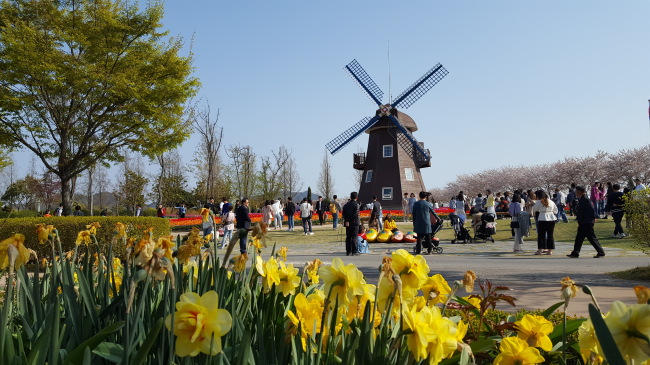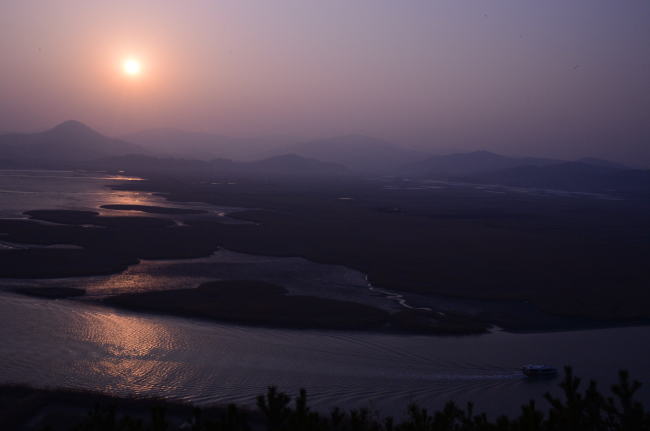SUNCHEON, South Jeolla Province -- Stepping off the KTX, I was welcomed by light drizzle and clouded skies in Suncheon, a city on the southwestern coast of the peninsula. It was perhaps a befiting first impression of a city that holds the record, set in 1998, for the most rainfall in one hour -- a whopping 145 millimeters.
Then again, the wet was what created the beautiful natural environment that makes the South Jeolla Province city such a worthwhile place to visit: from the botanical life and the marshes, to the mountains hosting scenic views and Buddhist temples.
One of the few regional steretypes that has proven to be true is that the people of Jeolla Province know how to cook. I dropped by Cheonghae Hanjeongsik, a local eatery famous for seafood, and the region lived up to its reputation.
Just make sure you know what hongeo is before ordering it, because while enjoyed by many, the fermented skate is a dish that will burn through your nose and mouth with its pungent odor.
Daewon Sikdang is another of famous restaurant in the region, this one specializing in Korean traditional food that really strained the table supports with its massive variety of dishes.
 |
Suncheonman Bay National Garden (Kim Jong-baek) |
Suncheonman Bay National Garden
The first stop on the schedule was the Suncheonman Bay National Garden, established in 2013 as the first national garden for the Suncheon Bay International Garden Expo 2013. It reopened the following year as a permanent establishment, and is now the biggest tourist spot in the city, pulling in 6.1 million of its 9 million tourists in 2017.
Spanning across more than 1.1 square kilometers, the garden has over 5 million plants and 880,000 trees. Each season, the place sheds its skin by redecorating itself with new array of flowers.
According to my tour guide, azaleas and roses are two heroines of the garden in May.
The garden is divided into different sections each of which has its own theme. One was themed after the world’s different garden styles. While strolling across the park, I stepped across the arch columns that took me inside the Italian Garden. The Dutch Garden is filled with tulips and other flowers that surround a model windmill.
 |
Suncheonman Bay National Garden (Kim Jong-baek) |
The arboretum zone features various paths and Korean traditional gardens.
Located in the Wetland center is the Dream Bridge, which is an art piece in itself. It is suspended across the river and holding drawings of 140,000 children from across the world. The place also has a zoo that is home to flamingos, seals, the enormous Aldabra giant tortoise, and Fennec foxes, a family of which recently celebrated the birth of two cubs.
The Wetlands
Mudflats and fields of reeds stretch as far as the eye could see on the wetlands of the bay, just a short drive away from the garden. It is spread across 22.6 square kilometers and is home to indigenous wildlife on land, water and the skies.
The thousands of hooded cranes that usually occupy the area had already moved out, but herons were gliding above the river, or resting in the muddy shallows. A small boat that carries 30 passengers is operated at the bay, which takes 35 minutes to sail across the wetlands and requires a photo ID to board.
A better view of the marshlands is available from the Yongsan Observatory, which also offers a fascinating view of the dusk. Check the weather before visiting, because it makes a huge difference to how the wetlands look.
 |
Sunset photographed from Yongsan Observatory |
Songgwangsa TempleThose looking to taste the traditional culture can walks the slopes of Jogyesan on a quest for Songgwangsa, a temple built with hopes of spreading Buddhism throughout the world. Drive along route No.18 to Juam IC, which should take you about 15 minutes to the temple.
Designated as a national treasure of Korea in 1962, the temple was completely destroyed in a fire in 1842, but was rebuilt. It has since undergone several reconstructions. It was founded by Jinul, the founder of the Jogye order and one of the most famous zen masters in Korea.
One of the unusual things about the temple is that it has no pagoda like other large Buddhist temples in the country.
“The foundation of the temple is in the form of a lotus floating on water,” the city’s culture guide Park Da-in explained. This is according to Pungsu Jiri (Feng Shui), and the builders deliberately avoided building pagodas to avoid the “lotus from sinking,” also a geomancy belief.
After a tour of the temple, a sign post led me to a hike toward Bulilam hermitage, on the aptly-named “road of no possession.” What was waiting at the end of the surprisingly taxing 40-minute hike was a place of tranquility, and the final resting place of respected Buddhist monk Bojsong.
In order to promote the city, authorities declared 2019 a year to visit suncheon, offering discounts from 1,000 won to 5,000 won ($4.3) on entrance fees at major tourist spots.
By Yoon Min-sik
(
minsikyoon@heraldcorp.com)










